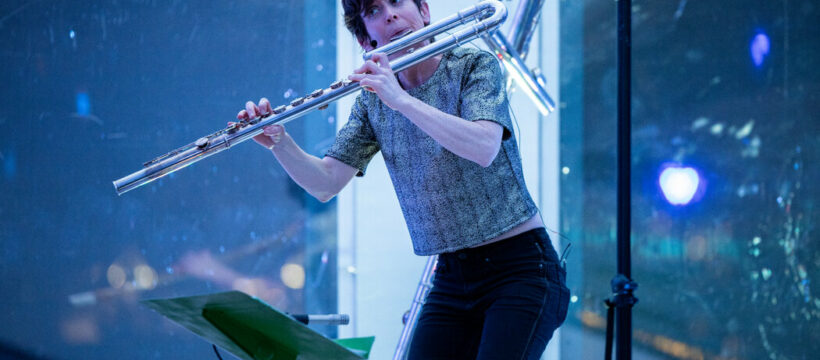The flutist Claire Chase is a community builder. You can see this in “Density 2036,” her 24-year project to commission a new repertoire for her instrument. And you can sense a communal spirit when she offers gratitude to audiences who show up to several gigs in a row.
This week, Chase voiced her appreciation to those who had attended multiple concerts in her recent 10th-anniversary “Density” retrospective at the Kitchen’s temporary location, in the Westbeth complex, and Zankel Hall.
“It’s a lot of flute,” she acknowledged on Wednesday at the Kitchen. (Listeners beyond New York can experience something similar, with most of “Density” available to hear in recordings gathered on Chase’s Bandcamp profile.)
True. But across two programs that night, Chase offered a generous spread of composers and their respective approaches to the flute family. As a result, the music never felt staid. You could enjoy the breathy qualities of pieces by Matana Roberts and Ann Cleare, as well as the harder-grooving material of works by Wang Lu and Craig Taborn.
Each installment of “Density” has a running time of about an hour. Some programs feature multiple pieces; some focus on just one. When the latter happens, there is an added sense of risk-taking, for listeners as well as for Chase. If a composition doesn’t hit strongly — well, that’s the whole hour.
That was my experience on Thursday night, when Anna Thorvaldsdottir’s “Ubique” premiered at Zankel. This work, like many in “Density” more than a mere flute solo, drew on the instrumental talents of Chase, the pianist Cory Smythe and the cellists Katinka Kleijn and Seth Parker Woods. (As was often the case during the retrospective, Levy Lorenzo steered the use of electronic sounds, and Nicholas Houfek provided subtle lighting design.)
In the early going of “Ubique,” Thorvaldsdottir writes ear-catching passages: flurries of rhythmically dynamic piano-and-flute passages, and some winning two-cello drones. But as these elements were reprised in the second half, it sounded like the material was being stretched, without much new added to the bargain.
At the other end of the spectrum, Chase’s willingness to give a composers an entire hour also paid dramatically satisfying dividends in the premiere of the improvising pianist and composer Craig Taborn’s “Busy Griefs and Endangered Charms” at the Kitchen. It was one of the best shows I’ve experienced this season.
Taborn is storied in contemporary jazz, with pianism of delicacy, intricacy and power. His 2011 debut solo recording for ECM, “Avenging Angel,” is among the best piano works of this century, and in recent compositions for his Junk Magic ensemble, he has also been edging into chamber-like arrangements.
So, Chase was wise to ask Taborn for a program-length “Density” piece. “Griefs” placed him in a quartet alongside Chase, the clarinetist Joshua Rubin and the percussionist Susie Ibarra. (Ibarra, also a key presence on jazz stages, has also recently performed the works of Pauline Oliveros with Chase.)
“Griefs” begins with chiming synth figures on a digital loop, plus some thick, doleful acoustic piano harmonies; as is his regular practice, Taborn manipulated a small electronic manual that rested atop his piano. After Rubin entered on bass clarinet, Taborn’s articulation of the opening material accelerated, though the somber mood remained intact.
It took five minutes for Chase to enter on a flute — but once she did, Taborn’s piece moved from its griefs to its charms. Across the hour, Chase was given space to partner with every other player in duos, all of which took advantage of Taborn’s invitations to improvise. With Rubin, she steered unison lines that gradually branched into rhythmically independent cries; the sneaky effect had the quality of Taborn’s own pianism. With Ibarra, she reveled in funk-laced passages. And with Taborn, she collaborated on long-lined melodies and freer sounding improvisations.
Taborn himself took a few dramatic solos of his own, which were rambunctious and lyrical in equal measure. But he was also silent for significant stretches, listening closely to the other musical partnerships he’d set in motion. There was always something to savor.
After the concert, I asked Taborn whether I’d missed out on any other similar chamber music of his. He mentioned some two-piano pieces that he has developed with Smythe — the pianist in the Thorvaldsdottir premiere — but said that “Griefs” was the first such piece of his at that scale. (And on June 24 at National Sawdust, Taborn will premiere the first part of a work in progress, for string quartet and his own piano.)
Craig Taborn and Cory Smythe – X’s and Y’s | International Contemporary Ensemble from Digitice on Vimeo.
When Chase gets around to recording and releasing this part of “Density,”, Taborn’s work deserves to be a big event in multiple music circles. For now, the premiere is emblematic of the kind of concert that Chase knows how to ask for, before any other classical music presenter. It’s the kind of piece that can only be commissioned by a soloist who is a close listener to the broad community of living American composers. And that’s a trait for which audiences are rightly grateful.
Source: Read Full Article
